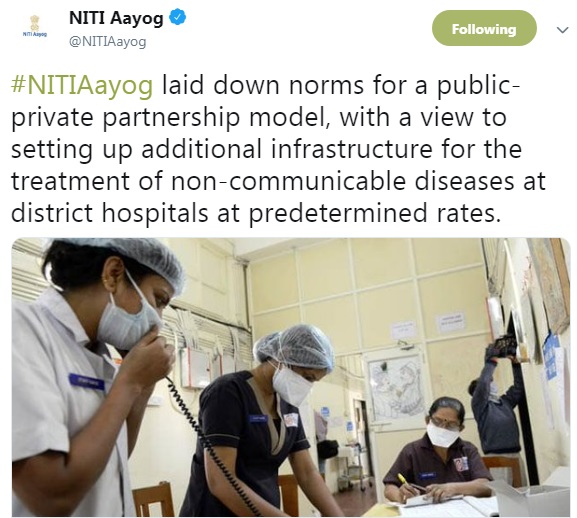NITI Aayog launched, on October 17, 2018, the Guidelines and Model Concessionaire Agreement (MCA) for Public Private Partnership (PPP) for Non Communicable Diseases. The documents have been designed to supplement efforts for provision of prevention and treatment services of non-communicable diseases related to Cardiac Sciences, Oncology, and Pulmonary Sciences at the district hospitals especially in tier 2 & 3 cities.

(Also read: Home Ministry launches portal for reporting Online Sexual Abuse and Cyber Crimes)
The documents have been developed by NITI Aayog in partnership with the Ministry of Health and Family Welfare, State Governments and representatives from the healthcare industry. Member NITI Aayog, Dr. VK Paulalong with partner agencies involved in preparation of the two documents were present on this occasion.
(Also read: Air Quality Early Warning System for Delhi launched)
Salient features:
i. PPP Units to be established in District Hospitals
ii. Model covers prevention and treatment of 3 Non-Communicable Diseases viz. Cardio Vascular diseases, Cancers and Pulmonary diseases.
iii. Scope of services:
a) Oncology: Palliative care, Medicinal /Conservative Management (including Chemotherapy, Growth Inhibitors & Hormone Therapy)
b) Pulmonology: Emergency Management of acute syndromes, Medicinal/Conservative Management for COPD, Bronchial Asthma and Bronchoscopy.
c) Cardiology: Emergency Management of acute syndromes, Medicinal/Conservative Management and Angiography/Angioplasty.
iv. All these services in PPP facility to be offered by a Single partner or a single consortium of private partners.
v. Private partner to invest in upgrading/building and equipping the facility and responsible for operational management and service delivery.
vi. Government to provide physical space & other infrastructure in ‘as-is where-is’ condition, provide support facilities and hospital amenities.
vii. User Fee to be fixed as the package rates discovered periodically through States/ Centre Insurance Scheme(s). States which do not have such insurance packages, could use CGHS package rates for period when such insurance rates are not available.
viii. Viability Gap Funding (VGF) to be provided by the government(s) should be used as the parameter for bidding in the project.
(Also read: A Museum on Prime Ministers of India to be set up in Delhi)
Background:
The guidelines come in the backdrop of the fact that the contribution of non-communicable diseases (NCD) to the overall disease burden in the country has increased over the years. In the past many district hospitals in the country have focused mainly on communicable diseases and reproductive and child health. As a result of which the capacity for handling NCD cases has not been adequately developed.
(Also read: No Cost EMI is not interest free, know how No Cost EMI works)
Health and wellness component of Ayushman Bharat will address the requirements of preventive and promotive health services through Health & Wellness Centres. Despite the best intent to promote wellness and deliver a broad range of services through these Centres, some cases will require hospitalized treatment and will spill over to district hospitals.
(Also read: Online Safety Tips for Parents, Youngsters and Organisation)
Presently, in India patients have to travel long distances for availing medical services for NCDs due to urban bias in the availability of private health care, especially secondary and tertiary care which is disproportionately skewed towards Tier-1 cities. The patients in mofussil towns and rural areas are largely underserviced. In this context, PPP for NCDs in district hospitals will play a pivotal role in ensuring the availability of the services at least at the district headquarters.
(Also read: What is Sexual Harassment and its Punishment)
The Model Concessionaire Agreement and the guidelines co-locating private players for the Non Communicable Diseases - Cardiac, Oncology, and Pulmonary diseases at district hospital covers the rationale, roles and responsibilities, partnership structure, governance and management structure etc. These PPP guidelines and MCA target the critical gaps that can be filled by ‘strategic purchasing’ in public health services highlighted in the National Health Policy 2017. This would play a key role in directing private investment towards those areas and those services for which currently there are no providers or few providers.
(Also read: SBI Net Banking facility may be blocked if Mobile Number is not registered by Dec 1, 2018)
The MCA and Guidelines for the provision of prevention and treatment services for NCDs could be adapted and customized by each State to ultimately develop appropriate strategies in accordance with the requirements provided in these documents. This will make it easier for the State to use these templates and modify them appropriately to invite bidders.
For more updates:
1. Like our Facebook Page
2. Join our Telegram Group
3. Join our Facebook Group
4. Subscribe to our Youtube Channel
5. Follow us on Twitter
6. Follow us on Instagram
Disclaimer: The above post includes some content used from PIB India website and executed on this website for fair use only. As this website is of educational nature, hence the content is used for education and awareness to the public.

